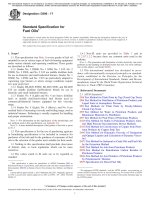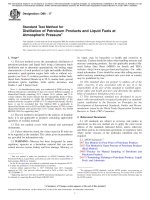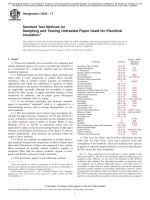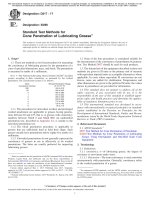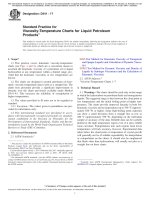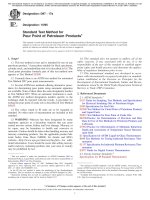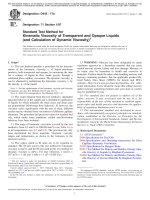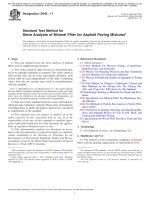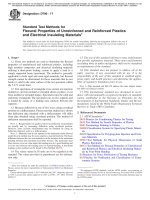Astm d 425 17
Bạn đang xem bản rút gọn của tài liệu. Xem và tải ngay bản đầy đủ của tài liệu tại đây (256.57 KB, 5 trang )
This international standard was developed in accordance with internationally recognized principles on standardization established in the Decision on Principles for the
Development of International Standards, Guides and Recommendations issued by the World Trade Organization Technical Barriers to Trade (TBT) Committee.
Designation: D425 − 17
Standard Test Method for
Centrifuge Moisture Equivalent of Soils1
This standard is issued under the fixed designation D425; the number immediately following the designation indicates the year of
original adoption or, in the case of revision, the year of last revision. A number in parentheses indicates the year of last reapproval. A
superscript epsilon (´) indicates an editorial change since the last revision or reapproval.
responsibility of the user of this standard to establish appropriate safety and health practices and determine the applicability of regulatory limitations prior to use.
1. Scope*
1.1 This test method covers the determination of the moisture equivalent of soil in the laboratory by means of a
centrifuge technique.
2. Referenced Documents
1.2 This test method is limited to specimens of coarsegrained sandy soils having a maximum particle size of less than
2.00 mm and with fines of low plasticity. Soils having a unified
soil classification, based upon procedures outlined in Practice
D2488 such as SP, SW, SC-SM, or SM are considered
acceptable for the test method.
1.2.1 For soils that are predominantly fine-grained, coarsegrained soils with medium to high plasticity, intact specimens
or soils being tested at a specific density or unit weight refer to
Test Methods D6836.
2.1 ASTM Standards:2
D653 Terminology Relating to Soil, Rock, and Contained
Fluids
D2216 Test Methods for Laboratory Determination of Water
(Moisture) Content of Soil and Rock by Mass
D2487 Practice for Classification of Soils for Engineering
Purposes (Unified Soil Classification System)
D2488 Practice for Description and Identification of Soils
(Visual-Manual Procedure)
D3740 Practice for Minimum Requirements for Agencies
Engaged in Testing and/or Inspection of Soil and Rock as
Used in Engineering Design and Construction
D4753 Guide for Evaluating, Selecting, and Specifying Balances and Standard Masses for Use in Soil, Rock, and
Construction Materials Testing
D6026 Practice for Using Significant Digits in Geotechnical
Data
D6836 Test Methods for Determination of the Soil Water
Characteristic Curve for Desorption Using Hanging
Column, Pressure Extractor, Chilled Mirror Hygrometer,
or Centrifuge
E11 Specification for Woven Wire Test Sieve Cloth and Test
Sieves
1.3 This test method is intended to be performed in a
constant temperature environment. Variations in temperature
exceeding the range outlined in 8.7 may influence the test data.
1.4 Units—The values stated in SI units are to be regarded
as the standard except for sieve designations, which also
include the “alternative” system in accordance with E11.
1.5 All recorded and calculated values shall conform to the
guide for significant digits and rounding established in Practice
D6026.
1.6 The procedures used to specify how data are collected/
recorded and calculated in this standard are regarded as the
industry standard. In addition, they are representative of the
significant digits that generally should be retained. The procedures used do not consider material variation, purpose for
obtaining data, special purpose studies, or any considerations
for the user’s objectives; and it is common practice to increase
or reduce significant digits of reported data to commensurate
with these considerations. It is beyond the scope of these test
methods to consider significant digits used in analysis methods
for engineering design.
1.7 This standard does not purport to address all of the
safety concerns, if any, associated with its use. It is the
3. Terminology
3.1 Definitions:
3.1.1 For definitions of common technical terms used in this
standard, refer to Terminology D653.
3.2 Definitions of Terms Specific to This Standard:
3.2.1 capillary fringe zone—the zone above the free water
elevation in which water is held by capillary action.
1
This test method is under the jurisdiction of ASTM Committee D18 on Soil and
Rock and is the direct responsibility of Subcommittee D18.03 on Texture, Plasticity
and Density Characteristics of Soils.
Current edition approved Jan. 15, 2017. Published January 2017. Originally
approved in 1935. Last previous edition approved in 2008 as D425 – 88 (2008).
DOI: 10.1520/D0425-17.
2
For referenced ASTM standards, visit the ASTM website, www.astm.org, or
contact ASTM Customer Service at For Annual Book of ASTM
Standards volume information, refer to the standard’s Document Summary page on
the ASTM website.
*A Summary of Changes section appears at the end of this standard
Copyright © ASTM International, 100 Barr Harbor Drive, PO Box C700, West Conshohocken, PA 19428-2959. United States
1
D425 − 17
3.2.2 centrifuge moisture equivalent—the water content of a
soil after it has been saturated with water and then subjected for
one hour to a centrifugal force equal to 1000 times that of
gravity.
6. Apparatus
6.1 Centrifuge—A centrifuge capable of generating a force
equal to 1000 times the force of gravity on the center of gravity
of the soil specimen for a period of 1 h. The centrifuge chamber
shall be capable of maintaining a controlled temperature of 20
6 1°C. In place of a temperature controlled chamber, the entire
centrifuge may be operated in a controlled environment capable of meeting the temperature requirement of 20 6 1°C.
6.1.1 The revolutions per minute, N, required to provide a
centrifugal force of 1000 times gravity is determined from the
equation:
3.2.3 specific retention—the ratio of the volume of water
that cannot be drained from a saturated soil under the action of
force of gravity to the total volume of voids.
3.2.4 water-holding capacity—the smallest value to which
the water content of soil or rock can be reduced by gravity
drainage.
4. Summary of Test Method
N5
4.1 The centrifuge moisture equivalent of soils is determined by initially air-drying the soil sample. Two 5-g test
specimens are selected from the sample and thoroughly soaked
in distilled or deionized water. The specimens are centrifuged
for 1 h at a force equal to 1000 times that of gravity at a
constant temperature of 20 6 1°C. The moisture content is
determined after centrifuging in accordance with Test Methods
D2216. The average of the two water contents is the moisture
equivalent of the soil.
Œ
RCF
0.00000111 rm
(1)
where:
N
= revolutions per minute,
RCF = relative centrifugal force (1000),
r
= radius of rotation to center of gravity of the test
specimen, mm, and
m
= mass of the body, taken as unity.
For most standard centrifuges, N will equal approximately
2300 rpm.
6.2 Gooch Crucible—Two procelain Gooch crucibles having a capacity of approximately 25 mL, and a diameter at the
bottom of the crucible of about 20 mm (Fig. 1). The crucible
shall have a perforated bottom and be compatible for use with
the centrifuge being used.
5. Significance and Use
5.1 All water contained in a saturated soil cannot be
removed by gravity drainage alone. The amount of water
retained after gravity drainage is usually expressed as the water
holding capacity or specific retention of the soil. These values
may be influenced by elapsed time, the particle-size distribution and the plasticity of the soil. In most cases, as the plasticity
increases so does the moisture equivalent value.
6.3 Babcock Trunnion Cups—At least two centrifuge cups
with caps and with a crucible holder for supporting the Gooch
crucible above the bottom of the cup (Fig. 1). The holder shall
have sufficient clearance to fit fully within the cup and support
the cup in such a manner that the water removed during the
centrifuging operation does not come in contact with the
crucible and soil. Cups and crucible holders shall be balanced
in pairs opposite each other in the centrifuge.
5.2 The centrifuge moisture equivalent is determined by
applying a centrifugal force great enough to reduce the
capillary fringe zone sufficiently so that it can be ignored
without introducing error. The centrifical force is maintained
sufficiently low as not to withdraw a large proportion of the
water that is held securely above the capillary fringe (see Note
1).
6.4 Filter Paper—A circular piece of filter paper of sufficient size to cover the inside bottom of the Gooch crucible (see
Note 3).
5.3 It has been determined that for at least medium-textured
soils (sandy to silty particle-size distribution) the centrifuge
moisture equivalent approximates the water holding capacity
and when combined with the bulk density can be used to
calculate an approximate specific retention and specific yield.
These properties when combined with porosity can be used to
estimate aquifer storage coefficient.
NOTE 3—A medium speed, high wet strength (hardened) filter paper is
recommended.
6.5 Balance—A balance having a readability of 0.01 g, and
accurate to 60.03 g, conforming to Specification D4753.
6.6 Humidifier—A cabinet or large jar with water in the
lower half of the container. A shelf positioned above the level
of the water should be covered with moisture resistant fabric on
which to store the crucibles and soil specimens.
NOTE 1—If a soil will hold water 100 mm by capillarity acting against
gravity, the soil will theoretically be able to hold the water only 0.1 mm
against a centrifugal force that is 1000 times greater than the force of
gravity.
NOTE 2—The statements on precision and bias contained in this test
method; the precision of this test method is dependent on the competence
of the personnel performing it, and the suitability of the equipment and
facilities used. Agencies that meet the criteria of Practice D3740 are
generally considered capable of competent and objective testing. Users of
this test method are cautioned that compliance with Practice D3740 does
not in itself assure reliable testing. Reliable testing depends on many
factors; Practice D3740 provides a means of evaluating some of these
factors.
6.7 Oven—A thermostatically controlled drying oven, preferably of the forced-draft type, capable of maintaining a
uniform temperature of 110 6 5°C throughout.
6.8 Water Content Containers—Suitable containers made of
material resistant to corrosion and change in mass upon
repeated heating, cooling, and cleaning. Containers shall have
close-fitting lids to prevent loss of moisture from the soil prior
to the initial weighing and to prevent absorption of moisture
from the atmosphere following oven drying and before final
2
D425 − 17
FIG. 1 Crucible, Trunnion Cup, and Cup Holder
8.2 Loosely and evenly place the two soil specimens into
the paired crucibles.
weighing. One container is needed for each water content
determination. Containers should be 50-100 mL capacity (see
Note 4).
8.3 Place the crucibles in a pan of distilled or demineralized
water to a depth at least 5 mm above the height of the soil in
the crucible. Allow the soil to absorb water until fully saturated.
NOTE 4—It is recommended that the containers be numbered in pairs to
coincide with the crucible numbers.
6.9 Mortar and Pestle—A mortar and rubber-tipped pestle
suitable for breaking up the soil aggregations.
NOTE 5—Eight hours or overnight is normally sufficient time for the
soil to become saturated and is indicated by the presence of free water
covering the surface of the soil.
6.10 Sieve—2.00-mm (No. 10) mesh sieve conforming to
Specification E11.
6.11 A pan or container used to collect the sample once
passed through the 2.00-mm (No. 10) sieve.
8.4 Place the crucible and specimen in the humidifier to
drain for at least 12 h to obtain uniform distribution of water
throughout the soil mass.
7. Samples and Specimens
8.5 Pour or siphon off any water remaining above the
surface of the specimens.
7.1 Air dry the as-received soil sample. Break up the
aggregations thoroughly using the mortar and pestle. Dry sieve
the sample through the 2.00-mm (No. 10) sieve.
8.6 Place the paired crucibles into the centrifuge cups fitted
as described in 6.2 and position opposite each other in the
centrifuge.
7.2 Thoroughly mix the sample and split by use of a sample
splitter or quartering method to obtain about 50 g of air-dried
soil.
8.7 Maintain the centrifuge environment at a temperature 20
6 1°C and adjust the centrifuge to the required speed within 5
min by five incremental and equal steps.
7.3 Obtain two 5-g specimens of material for testing. The
crucibles shall be paired in such a way that the masses of the
crucibles and contents meet the requirements of the manufacturer of the centrifuge.
8. Procedure
8.8 Maintain the centrifuge speed and temperature for 60
min. The speed of the centrifuge shall exert a centrifugal force
1000 times greater than that of gravity upon the center of
gravity of each of the test specimens.
8.1 Place a disk of wet filter paper on the bottom of the two
crucibles. The filter paper shall cover the entire bottom of the
crucible but not rest on the crucible’s wall.
8.9 Following the 60 min centrifuging period, allow the
centrifuge to come to rest with as little braking as possible, but
not to exceed a 5-min time interval.
3
D425 − 17
9. Calculation
8.10 Immediately after centrifuging, transfer the soil from
the two crucibles to water content containers as quickly as
possible to minimize moisture loss. It is not necessary to
remove all of the soil from the crucibles.
8.10.1 Determine the water content of each specimen in
accordance with Test Methods D2216.
9.1 Calculate the centrifuge moisture equivalent as the
average of the water contents of the two specimens as
determined by Test Methods D2216.
10. Report: Test Data Sheet(s)/Form(s)
8.11 If water is observed on the top of the soil after
centrifuging, the soil is said to have water-logged. The centrifuge moisture equivalent is not considered to be valid for this
material and the report should be so noted.
10.1 The methodology used to specify how data are recorded on the test data sheet(s)/forms(s), as given below, is
covered in 1.6.
10.2 Record as a minimum the following information
(data):
8.12 A sample data sheet is shown in Fig. 2.
FIG. 2 Centrifuge Moisture Equivalent Sample Data Sheet
4
D425 − 17
10.2.1 Name of the person performing the test.
10.2.2 Identification of sample including project number,
project name, boring number, sample number, and depth if
appropriate.
10.2.3 Description of the soil including the Unified Soil
Classification following Practice D2487 or D2488.
10.2.4 The average centrifuge moisture equivalent of the
specimen to the nearest 1 %.
10.2.5 If one or both of the specimens were water-logged,
the report shall state that the centrifuge moisture equivalent
was not valid for the soil tested.
11. Precision and Bias
11.1 Precision—Information on the precision of this test
method is being gathered.3
12. Keywords
12.1 centrifuge moisture equivalent; specific retention; specific yield, storage capacity; water holding capacity
3
For a discussion of variables which affect the results of this test, see Johnson,
A. I., Prill, R. C., and Morris, D. A., “Specific Yield–Column Drainage and
Centrifuge Moisture Content,” U.S. Geological Survey Water Supply Paper 1662-A,
1963.
SUMMARY OF CHANGES
In accordance with Committee D18 policy, this section identifies the location of changes to this standard since
the last edition (1988 (Reapproved 2008)) that may impact the use of this standard. (January 15, 2017)
(6) Section 6. Apparatus: Clarified wording.
(7) Section 7. Revised section to conform to D18 SPM
(8) Section 8. Procedure revised much of the text and added
subsections to more easily differentiate the necessary steps.
(9) Section 10. Report: Revised to bring into conformance with
D18 SPM.
(10) Added summary of changes.
(1) Section 1. Scope: Revised section by adding reference to
D6026, updating reference to alternative test methods. Added
subsection on how data are collected.
(2) Section 2. Referenced Documents: Added pertinent standards to the list and removed discontinued standards.
(3) Section 3. Terminology: Updated reference to D653.
(4) Section 4. Summary of Test Method: Clarified wording.
(5) Section 5. Significance and Use: Clarified wording; added
Note 1 on how the test works; and Note 2 on the reference to
D3740.
ASTM International takes no position respecting the validity of any patent rights asserted in connection with any item mentioned
in this standard. Users of this standard are expressly advised that determination of the validity of any such patent rights, and the risk
of infringement of such rights, are entirely their own responsibility.
This standard is subject to revision at any time by the responsible technical committee and must be reviewed every five years and
if not revised, either reapproved or withdrawn. Your comments are invited either for revision of this standard or for additional standards
and should be addressed to ASTM International Headquarters. Your comments will receive careful consideration at a meeting of the
responsible technical committee, which you may attend. If you feel that your comments have not received a fair hearing you should
make your views known to the ASTM Committee on Standards, at the address shown below.
This standard is copyrighted by ASTM International, 100 Barr Harbor Drive, PO Box C700, West Conshohocken, PA 19428-2959,
United States. Individual reprints (single or multiple copies) of this standard may be obtained by contacting ASTM at the above
address or at 610-832-9585 (phone), 610-832-9555 (fax), or (e-mail); or through the ASTM website
(www.astm.org). Permission rights to photocopy the standard may also be secured from the Copyright Clearance Center, 222
Rosewood Drive, Danvers, MA 01923, Tel: (978) 646-2600; />
5
